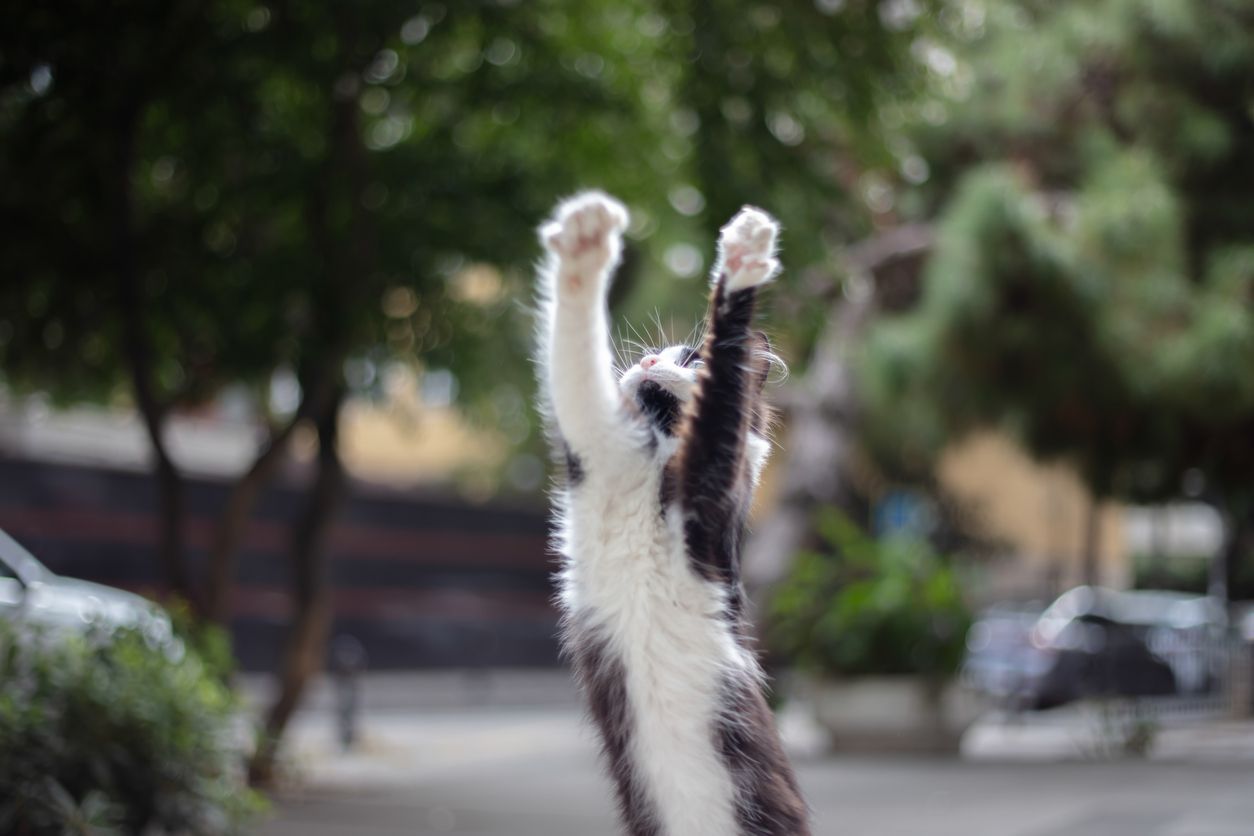Why is my cat having trouble jumping up to high places?

Disclaimer: This article, its content and related references do not constitute veterinary advice and should not be considered a substitute for veterinary care. If your pet is showing any symptoms that could indicate a medical emergency, please seek immediate emergency care.
Various health issues affect a cat’s natural instincts to climb and jump. There are many potential reasons why a cat may not be able to jump to high places, such as windowsills and cat trees, as well as they could before. Osteoarthritis is a common cause of mobility problems as cats age. Symptoms can be subtle, and it’s important to talk to a veterinarian any time your cat shows signs of illness or changes in their normal behavior. Read on to learn:
- Common causes of mobility issues in cats
- How to help cats with arthritis and other mobility problems
- How the cause of mobility challenges are diagnosed and treated in cats
Arthritic cats may have difficulty jumping, use their front claws to climb instead of jumping, or spend less time in their favorite high places. Arthritis symptoms can be difficult to identify and treat medically in cats due to their stoic nature and sensitivity to many nonsteroidal anti-inflammatory medications (NSAIDs). Weight management, home modifications (such as low-sided litter boxes), and encouraging gentle exercise are often used to help arthritic cats with their day-to-day lives.
Why is my cat having trouble jumping?
There are a variety of reasons why a cat may have difficulty jumping, hesitate to jump, or spend less time in favorite elevated places, such as windowsills and the tops of cat trees. Common health issues that affect mobility include:
- Osteoarthritis
- Obesity
- Injuries, such as fractures, dislocations, sprains, and strains
- Neurologic disorders
- Other musculoskeletal conditions
Osteoarthritis (OA) is a common medical issue in cats that affects a cat’s ability to jump. OA is the most common type of joint inflammation (arthritis) in cats and is especially common in seniors. OA is progressive and occurs when the cartilage and fluid in joints wear away, allowing the bones to painfully rub against each other. OA is a likely culprit if a senior cat, who seems fine otherwise, is unable or unwilling to jump to high places where they previously spent a lot of time.
It’s important to seek a proper diagnosis from a veterinarian rather than assuming your senior cat has arthritis, as many other medical conditions can cause similar symptoms. Osteoarthritis is rare in young cats, so a vet visit is warranted if a young cat cannot or will not jump anymore.
Signs of arthritis in cats
Common symptoms of arthritis in cats occur due to joint pain, inflammation, and stiffness associated with the disease. Signs of arthritis in cats include:
- Reluctance to jump, climb, or play
- Reduced activity
- Changes in posture
- Urinating or defecating outside of the litter box
- Decreased grooming resulting in an unkempt coat
- Irritability or aggression
- Hiding more than usual
- Swollen joints
A cat with arthritic back legs may use their front claws to climb instead of jumping to high places. Cats are stoic by nature, so symptoms of arthritis may be subtle and are often demonstrated as changes in normal behavior. Obvious symptoms, such as limping or crying in pain, are rare in cats with osteoarthritis, even when the cat’s in severe pain. By the time behavioral or physical changes are seen, the disease is likely severe, even if the symptoms seem minor.
What to do if your cat is having mobility problems
If your cat is showing signs of arthritic joints, there are things you can do to help. Veterinarians utilize a multimodal approach to managing osteoarthritis in cats, including steps cat owners can take at home.
Talk to a vet
The first step to take any time your cat is showing signs of illness or discomfort is to consult a veterinarian, even if the symptoms seem minor. It’s important to talk to a vet before attempting at-home treatments, such as offering pain relief or other medications. If the symptoms are severe enough to consider medications, a vet visit is warranted. A veterinarian can definitively diagnose the cause of your cat’s mobility problems. There are many health issues that can make it difficult for a cat to jump normally, and an accurate diagnosis is necessary for safe and effective treatment.
Maintain a healthy weight
Obesity can affect a cat’s ability to jump normally as well as make OA symptoms worse due to added pressure on the joints. Weight loss is often one of the first steps recommended by veterinarians to relieve symptoms and slow the progression of the condition. Work with a veterinarian to establish the right portion size, type of food, and feeding schedule based on your cat’s individual needs.
Modify their environment
Modifying an arthritic cat’s home environment can help make their daily habits less painful. Adjustments may include:
- Using low-sided litter boxes
- Elevated water and food bowls
- Providing pet ramps to favorite elevated spots
- Using flat or slanted scratching mats instead of vertical posts
- Providing ample soft, heated beds
- Keeping essential and favorite items on one floor of the home
Limiting the amount of jumping and climbing a cat needs to do every day can help ease joint pain and mobility challenges.
How vets diagnose and treat mobility issues in cats
A veterinarian usually starts with a thorough physical exam when a cat presents with mobility challenges. X-rays and other diagnostic tests may be recommended depending on the cat’s symptoms and what is detected in the exam. Symptoms of mobility issues can be easily overlooked in cats due to:
- Their tendency to hide symptoms
- Their apparently high tolerance for pain
- Their limited cooperativeness in the veterinary exam room
Some perfectly healthy cats may refuse to walk, flinch away when touched, or become irritable or aggressive when at a veterinary clinic, so diagnosing the underlying cause of a mobility issue without X-rays can be challenging, especially in the earlier stages of the disease.
Treatment options vary depending on the underlying cause of the cat’s symptoms, but may include:
- Weight management
- Treating musculoskeletal injuries
- Managing neurologic conditions
- Antibiotics for bacterial infections
- Pain management
- Nonsteroidal anti-inflammatory medications (NSAIDs)
Options for the management of osteoarthritis in cats are limited. “Cats are highly sensitive to the NSAIDs that are used to treat arthritis in dogs and people and typically do not respond well to them,” explains Dr. Jo Myers, a veterinarian on the Vetster platform. “It’s critical to use only oral and monthly injectable medications with reasonable safety profiles for cats, and to also provide other forms of management.” This may include:
- Maintaining a healthy weight
- Home modification and adaptation
- Encouraging gentle exercise
- Joint supplements and injections
- Pain management and anti-inflammatories
If your cat is showing changes in their mobility, such as spending less time in favorite elevated spots around the home or having difficulty jumping, veterinary care is warranted. An online virtual care appointment is an excellent way to show a veterinarian a cat’s mobility issue without the stress of going to a hospital. Online vets can also help form nutrition plans for weight loss and offer additional arthritis management advice tailored to your cat’s individual needs.
FAQ - Why is my cat having trouble jumping up to high places?
Do cats struggle to jump when they get older?
Osteoarthritis is a common condition that develops as cats age and affects their ability to jump, climb, and run. However, just because arthritis is common in senior cats that doesn’t mean it’s the only thing to cause these symptoms or that they should be ignored. It’s important to get veterinary care for your senior cat when they show signs of mobility problems to get a definitive diagnosis, provide pain relief, and slow the progression of the disease.
Why is my cat pulling herself up instead of jumping?
Cats who are having pain in their hind legs may climb with their front paws rather than jumping to certain locations. This pain can be caused by injuries, osteoarthritis, and a variety of other health issues. It’s important to talk to a veterinarian when you notice changes in mobility and normal behavior in your cat.
Why is my cat suddenly struggling to jump?
Injuries, osteoarthritis, infectious disease, and other health issues can cause mobility challenges in cats, leading to an inability to jump normally. A definitive diagnosis from a vet is necessary to determine the underlying cause of the symptoms due to the wide variety of conditions that can cause them.




